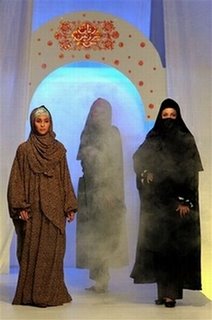Politics of fashion; fashion of politics
Frances Harrision writes for the BBC from Tehran about a police-sponsored fashion show and the politics of women's dress.I'd say it was progress in human rights if her statement "that imposing Islamic dress by force hasn't worked" is actually an observation accepted by those in power. However, it might be revolutionary (or counter revolutionary in Iran) if she is right that "Increasingly there is a recognition that women - rather than men - should be the ones who decide what kind of Islamic dress they wear..."
Iran police move into fashion business
"Women in high-heeled shoes and plenty of make-up strut down the catwalk amid clouds of artificial smoke. It is the first time live models have been allowed to appear in a fashion show in post-revolutionary Iran.

"The only unusual aspect is they're draped from head to toe in the all enveloping chador that hides everything except the face.
"It's part of a new drive to give women more attractive choices of Islamic dress that allow them to express their individuality, while remaining within the letter of the law.
"Not everyone in the all female audience was happy.
"'I don't think ordinary people will like this show because everything comes from Arab culture,' complains Faranak who says she wants something more Iranian and indigenous...
"Many young women born after the revolution do not seem to have accepted the official idea of Islamic dress.
"Conservative MP Rafat Bayat, who always wears a black chador, believes the problem is the state never educated young people properly.

"'The generation born after the revolution has grown up in families that do not believe in these principles and they are estranged from these laws,' she says.
"'We thought there would be no problem because we had an Islamic Republic and we thought everyone knew the constitution,' says Mrs Bayat with regret.
"According to the law, a woman who does not cover her hair and body in public can be fined or imprisoned for up to two months.
"But there are hundreds of shops throughout North Tehran selling glamorous strapless dresses and low-cut, beaded tops for women to wear at parties...
"'Observance of hijab has got worse since the new government because Mr Ahmadinejad is not that strict on this issue,' complains Mrs Bayat...
"Aware that imposing Islamic dress by force hasn't worked, Iran's police decided to hold their own fashion exhibition recently to educate women about what they should be wearing - though there were no live models.
"'We want to guide our designers to meet the needs of our society,' explained Sardar Ansari of the Iranian police force. 'We don't want them to get their ideas about fashion from satellite television.'...
"For many older women it's a symbol of their commitment to the revolution. But young women are increasingly turning away from the chador - it's expensive, hot and difficult to wear...
"Increasingly there is a recognition that women - rather than men - should be the ones who decide what kind of Islamic dress they wear...
"In other words, the establishment realises that the children of the revolution are rebelling against drab, uniform-style clothing, and it wants to keep them in line by offering a little glamour."



0 Comments:
Post a Comment
<< Home